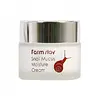What's inside
What's inside
 Key Ingredients
Key Ingredients

 Benefits
Benefits

 Concerns
Concerns

 Ingredients Side-by-side
Ingredients Side-by-side

Water
Skin ConditioningGlycerin
HumectantCetyl Alcohol
EmollientStearyl Alcohol
EmollientGlyceryl Stearate
EmollientCaprylic/Capric Triglyceride
MaskingParaffinum Liquidum
EmollientSnail Secretion Filtrate
Skin ConditioningBeeswax
Emulsion StabilisingCyclopentasiloxane
EmollientPEG-150 Distearate
EmulsifyingCyclohexasiloxane
EmollientPhenoxyethanol
PreservativeStearic Acid
CleansingAloe Barbadensis Leaf Extract
EmollientCarbomer
Emulsion StabilisingWater
Skin ConditioningIsononyl Isononanoate
EmollientOctyldodecanol
EmollientCyclohexasiloxane
EmollientGlycerin
HumectantPropylene Glycol
HumectantCetyl Alcohol
EmollientStearyl Alcohol
EmollientGlyceryl Stearate
EmollientMethyl Methacrylate Crosspolymer
PEG-75 Stearate
Paraffinum Liquidum
EmollientCeteth-20
CleansingPhenoxyethanol
PreservativeSteareth-20
CleansingCyclopentasiloxane
EmollientXanthan Gum
EmulsifyingChlorphenesin
AntimicrobialDisodium EDTA
Propolis Extract
Skin ConditioningAminoethanesulfinic Acid
AntioxidantSilica
AbrasiveCarnosine
Skin ConditioningMethylparaben
PreservativeDisodium Adenosine Triphosphate
Skin ConditioningPropylparaben
PreservativeLaminaria Digitata Extract
Skin ProtectingWater, Isononyl Isononanoate, Octyldodecanol, Cyclohexasiloxane, Glycerin, Propylene Glycol, Cetyl Alcohol, Stearyl Alcohol, Glyceryl Stearate, Methyl Methacrylate Crosspolymer, PEG-75 Stearate, Paraffinum Liquidum, Ceteth-20, Phenoxyethanol, Steareth-20, Cyclopentasiloxane, Xanthan Gum, Chlorphenesin, Disodium EDTA, Propolis Extract, Aminoethanesulfinic Acid, Silica, Carnosine, Methylparaben, Disodium Adenosine Triphosphate, Propylparaben, Laminaria Digitata Extract
Ingredients Explained
These ingredients are found in both products.
Ingredients higher up in an ingredient list are typically present in a larger amount.
Cetyl Alcohol is a fatty alcohol. Fatty Alcohols are most often used as an emollient or to thicken a product.
Its main roles are:
Though it has "alcohol" in the name, it is not related to denatured alcohol or ethyl alcohol.
The FDA allows products labeled "alcohol-free" to have fatty alcohols.
Learn more about Cetyl AlcoholCyclohexasiloxane is a type of silicone more commonly known as D6. It is an emollient and solvent.
Cyclohexasiloxane is used to evenly distribute ingredients throughout the product. When applied to the skin, Cyclohexasiloxane evaporates and leaves behind a silky feel.
As an emollient, it can help the skin feel soft and hydrated. It is also used to reduce frizz in hair products.
Learn more about CyclohexasiloxaneCyclopentasiloxane, or D5, is a silicone used to improve texture of products and trap moisture.
D5 is considered lightweight and volatile. Volatile means it evaporates quickly after application. Once evaporated, D5 leaves a thin barrier that helps keep skin hydrated.
It is also an emollient. Emollients help soften the skin and prevent water loss. Silicones create a silky texture in products. D5 helps other ingredients become more spreadable.
Studies show D5 is safe to use in skincare products. We recommend speaking with a skincare professional if you have concerns.
Learn more about CyclopentasiloxaneGlycerin is already naturally found in your skin. It helps moisturize and protect your skin.
A study from 2016 found glycerin to be more effective as a humectant than AHAs and hyaluronic acid.
As a humectant, it helps the skin stay hydrated by pulling moisture to your skin. The low molecular weight of glycerin allows it to pull moisture into the deeper layers of your skin.
Hydrated skin improves your skin barrier; Your skin barrier helps protect against irritants and bacteria.
Glycerin has also been found to have antimicrobial and antiviral properties. Due to these properties, glycerin is often used in wound and burn treatments.
In cosmetics, glycerin is usually derived from plants such as soybean or palm. However, it can also be sourced from animals, such as tallow or animal fat.
This ingredient is organic, colorless, odorless, and non-toxic.
Glycerin is the name for this ingredient in American English. British English uses Glycerol/Glycerine.
Learn more about GlycerinGlyceryl Stearate is a mix of glycerin and stearic acid.
It is used to stabilize the mixing of water and oil ingredients. By preventing these ingredients from separating, it can help elongate shelf life. It can also help thicken the product's texture.
As an emollient, it helps soften skin and supports barrier-replenishing ingredients.
In cosmetics, Glyceryl Stearate is often made from vegetable oils or synthetically produced.
This ingredient may not be fungal-acne safe
Fun fact: The human body also creates Glyceryl Stearate naturally.
Learn more about Glyceryl StearateParaffinum Liquidum is also known as liquid paraffin. It is a type of highly refined mineral oil.
Like other oils, Paraffinum Liquidum has emollient properties. Emollients help soothe and soften the skin. By creating a barrier to trap moisture within, emollients help keep your skin hydrated.
Paraffinum Liquidum does not irritate the skin and is non-comedogenic.
Learn more about Paraffinum LiquidumPhenoxyethanol is a preservative that has germicide, antimicrobial, and aromatic properties. Studies show that phenoxyethanol can prevent microbial growth. By itself, it has a scent that is similar to that of a rose.
It's often used in formulations along with Caprylyl Glycol to preserve the shelf life of products.
Stearyl Alcohol is a type of fatty alcohol from stearic acid. It is a white, waxy compound used to emulsify ingredients.
Fatty Alcohols are most often used as an emollient or to thicken a product. Emollients help soothe and hydrate the skin by trapping moisture.
They are usually derived from natural fats and oils and therefore do not have the same drying or irritating effect as solvent alcohols. FDA allows products labeled "alcohol-free" to have fatty alcohols.
Learn more about Stearyl AlcoholWater. It's the most common cosmetic ingredient of all. You'll usually see it at the top of ingredient lists, meaning that it makes up the largest part of the product.
So why is it so popular? Water most often acts as a solvent - this means that it helps dissolve other ingredients into the formulation.
You'll also recognize water as that liquid we all need to stay alive. If you see this, drink a glass of water. Stay hydrated!
Learn more about Water